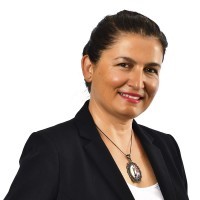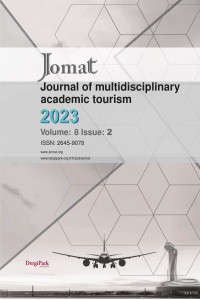Research Article
Systematic Reviews and Meta Analysis
Systematic Reviews and Meta Analysis
1. Scientific production on tourist security in the period 2002-2021Review
Theoretical Article
Aim & Scope
Journal of Multidisciplinary Academic Tourism (JOMAT) is an explicitly international and multidisciplinary peer-reviewed scientific journal founded in 2016. JOMAT aims to publish both empirically and theoretically based articles which advance and foster knowledge of tourism and research that explores one or more of the economic, social, cultural, political, organizational, marketing, management or environmental aspects of the subject. We are also trying to give a new perspective to tourism-related activities. The journal encourages short commentaries and rejoinders and provides a rapid turnaround of submissions. In addition to regular length submissions, the journal also welcomes extended peer-reviewed papers on a single topic that combines detailed literature reviews with substantive empirical research and policy analysis. We also welcome supplementary material in the form of video, audio, photographs and additional supplementary about data, not included in the paper. The journal publishes Main Papers, Book Reviews, Review Essays and occasional Opinion Pieces. Book reviews and Opinion Pieces are by invitation only.Indexes and PlatformsThis journal is abstracted and indexed by ULAKBIM TrDizin, CAB Abstract, Bilgindex, SOBIAD, CrossRef, Google Scholar, ASOS Index.
The Journal invites contributions related to the following subjects and their applications in tourism and hospitality: marketing management; innovations; global issues; economics; consumer behavior; organizational behavior; culture; methodology; sustainability; beverage management; planning and development; financial management; gender issues; ethics; entrepreneurship; education; and future trends. We also commission Special/Additional Issues – please contact the editors if you have a proposal for a Special Issue or Opinion Piece.
Author Guidelines
GENERAL GUIDELINES FOR AUTHORS
Manuscripts must be submitted electronically. It is necessary to create an account in the Dergipark system for Submission. Click to register. (https://dergipark.org.tr/en/register). Preferably, authors are expected to submit a Microsoft Word or pdf file. Please prepare the paper in accordance with the template prepared for Journal of Multidisciplinary Academic Tourism (Jomat). To download the template please click here. Make sure that there is no author information in the manuscript submitted to the system. Along with the Manuscript file, authors will be prompted to upload a Metadata file. Please click here to download the Metadata excel file. There are two pages you need to fill in the excel file you downloaded. Fill and save the “Metadata” and “Author Contribution” pages, respectively. Upload this file as an additional file together with the manuscript at the submission stage. Metadata excel file contains excel macros. Therefore, please make your activation process before you start filling out. Except for the manuscript and metadata, it is recommended that authors upload a "Title Page". It is also recommended to upload the dataset for empirical studies.
Manuscript Layout
1) The main document should contain the title (the title should be written in sentence format. In other words, only the first letter of the first word of the sentence should be capital letter), abstract, 3 to 7 keywords, text, appendices, notes, references, each table and figure. Tables and figures should be properly embedded in the manuscript. Footnotes in the paper should be numbered consecutively.
2) Abstract is to be 150 - 300 words. A concise and factual abstract is required. The abstract should state briefly the purpose of the research, methodology, the principal results and major conclusions.
3) There are no absolute word count requirements, but target lengths for research notes are 3,000 to 5,000 words all inclusive. A typical manuscript will not exceed 12,000 words.
The submitted manuscripts or substantial parts of them should not have been previously published or submitted for publication somewhere else. The abbreviated version of the contents for presentation at a meeting is not regarded as a publication.
All authors ensure that they have furnished a substantial contribution to the paper and that they are in agreement with form and contents of the manuscript. Corresponding authors confirm that they hold the copyrights to their articles as well as to the text and illustrations attached therein in the authors´ contract. If material (e.g., illustrations or tables) is used from other sources, authors must submit a written statement from the holder(s) of the copyright(s) indicating they have obtained permission to publish this material in jomat. The authors of articles published by jomat grant jomat the right to store the articles in its databases for an unlimited period of time and to distribute and reproduce the articles electronically. The authors retain all remaining exploitation rights to their articles, subject to the condition that any further use of the articles shall make reference to their original publication in jomat ("originally published in JOMAT").
Authors should indicate, either in their cover letter or in the title page, whether the research reported in their paper was the result of a for-pay consulting relationship or if they or their employer has a financial interest in the topic of the paper which might constitute a conflict of interest.
In general, papers may be of any length but should be self-contained. Further, they should provide new findings or deal with new methods.
Supplementary material, such as data sets etc., should be submitted together with the manuscript.
There is no submission and publication fees or page charges.
Submission
Manuscripts must be submitted electronically. It is necessary to create an account in the Dergipark system for Submission. Click to register. (https://dergipark.org.tr/en/register). Preferably, authors are expected to submit a Microsoft Word or pdf file. Please prepare the paper in accordance with the template prepared for Journal of Multidisciplinary Academic Tourism (Jomat). To download the template please click here. Make sure that there is no author information in the manuscript submitted to the system. Along with the Manuscript file, authors will be prompted to upload a Metadata file. Please click here to download the Metadata excel file. There are two pages you need to fill in the excel file you downloaded. Fill and save the “Metadata” and “Author Contribution” pages, respectively. Upload this file as an additional file together with the manuscript at the submission stage. Metadata excel file contains excel macros. Therefore, please make your activation process before you start filling out. Except for the manuscript and metadata, it is recommended that authors upload a "Title Page". It is also recommended to upload the dataset for empirical studies.
Manuscript Layout
1) The main document should contain the title (the title should be written in sentence format. In other words, only the first letter of the first word of the sentence should be capital letter), abstract, 3 to 7 keywords, text, appendices, notes, references, each table and figure. Tables and figures should be properly embedded in the manuscript. Footnotes in the paper should be numbered consecutively.
2) Abstract is to be 150 - 300 words. A concise and factual abstract is required. The abstract should state briefly the purpose of the research, methodology, the principal results and major conclusions.
3) There are no absolute word count requirements, but target lengths for research notes are 3,000 to 5,000 words all inclusive. A typical manuscript will not exceed 12,000 words.
References
The reference list should appear at the end of the text, with hyperlinks to full-text papers on the Web, and should start on a new page. Issue numbers, and pages should be provided for all journals cited in the references and should be APA 7 Style. For correct referencing through APA 7, below links can be advised for more information; https://apastyle.apa.org/style-grammar-guidelines/references/examples
Formulas
Displayed formulas should be numbered consecutively on the right as (1), (2), etc. All characters should be defined and used unambiguously. Standard italicization should be used. When referring to formulas in the text, only numbers in parentheses should be used, for example, (1). At the beginning of sentences, numbers in parentheses should be preceded by the word "equation", for example, Equation (1).
Tables
Tables should be of a reasonable number and size. Columns should be designed clearly and explanations should be given in footnotes using letters below the table body. Only the first word in each column heading and in each entry of the stub column should be capitalized. Titles should be formatted above the tables as follows:
Table 1: Result of measurement model
Note: The source should be indicated under each table. If the table was created by the author(s), it should be specified as follows:
Source: Authors elaboration
Figures
Figures should be complete and clearly drawn. Special care should be taken to ensure that lettering and symbols are of a comparable size and readable. Figures should not be overloaded with information. It is preferable to provide the figures as vectoral (scalable and editable) graphics. If not possible, a high resolution and dimensional image should be provided. It is recommended that the image be at least 300 dpi. However, a better resolution may be required depending on the visual content. When labeling, initial capitalization should be used. The Label should be below the shape, and should look like this:
Figure: Study region
Note: The source must be indicated under each Figure. If the figure was created by the author(s), it should be specified as follows:
Source: Authors elaboration
AUTHOR'S CONTRACT
In submitting papers to Jomat the authors certify that:
All authors contributing to a paper authorize the corresponding author to communicate with the journal. Corresponding author is responsible for communication on behalf of all authors and any confirmation and contract will be made between these two parties. The authors are deemed to have accepted this situation by submitting a paper to Jomat.It is recommended to have a maximum of 7 authors for a paper.
Corresponding authors warrant, on behalf of themselves and their co-authors, that: the article is original, has not been formally published in any other peer-reviewed journal, is not under consideration by any other journal and does not infringe upon any existing copyright or any other third party rights;
They are the sole authors of the article and have full authority to enter into this agreement and in granting rights to Jomat are not in breach of any other obligation. If the law requires that the paper be published in the public domain, they will notify Jomat at the time of submission.
the paper contains nothing that is unlawful, libelous, or which would, if published, constitute a breach of contract or of confidence or of commitment given to secrecy; they have taken due care to ensure the integrity of the article. To their best -and currently accepted scientific- knowledge all statements contained in it purporting to be facts are true and any formula or instruction contained in the article will not, if followed accurately, cause any injury, illness or damage to the user.
The author(s) are responsible for every content on the paper. By submitting a the paper, they are deemed to have accepted all of Jomat's rules and policies.
The authors agree that their papers may be published by JOMAT under a Creative Commons Attribution 4.0 (CC-BY).
Ethical Principles and Publication Policy
ETHICAL PRINCIPLES
All papers are subject to double blind peer review process based on an initial screening by the editor criteria and Committe on Publication Ethics(COPE)'s principles for evaluation include significant contribution to the field, conceptual quality, appropriate methodology and clarity of exposition. The publication of an article in a “double blind peer-reviewed” journal is essential in the development of a consistent and respected network of knowledge. In double blind peer-review, articles written by ‘prestigious’ or renowned authors are considered on the basis of the content of their papers, rather than on the author’s reputation. It is therefore essential to agree upon standards of expected ethical behavior for all parties involved in the act of publishing: the authors, the journal editor, the peer reviewers and the publisher. The authors should ensure that they have written entirely original works, and if the authors have used the work and/or words of others, that this has been appropriately cited or quoted.
About the Committee on Publication Ethics (COPE,https://publicationethics.org/)
COPE provides advice to editors and publishers on all aspects of publication ethics and, in particular, how to handle cases of research and publication misconduct. It also provides a forum for its members to discuss individual cases. COPE does not investigate individual cases but encourages editors to ensure that cases are investigated by the appropriate authorities (usually a research institution or employer). All COPE members are expected to apply COPE principles of publication ethics outlined in the core practices.
Editors' responsibilities
1- Publication decisions
The editor is responsible for deciding which of the papers submitted to the journal will be published. The editor will evaluate manuscripts without regard to the authors' race, gender, sexual orientation, religious belief, ethnic origin, citizenship, or political philosophy. The decision will be based on the paper’s importance, originality and clarity, and the study’s validity and its relevance to the journal's scope. Current legal requirements regarding libel, copyright infringement, and plagiarism should also be considered.
2- Confidentiality
The editor and any editorial staff must not disclose any information about a submitted manuscript to anyone other than the corresponding author, reviewers, potential reviewers, other editorial advisers, and the publisher, as appropriate.
3- Disclosure and conflicts of interest
Unpublished materials disclosed in a submitted paper will not be used by the editor or the members of the editorial board for their own research purposes without the author's explicit written consent.
Reviewers' responsibilities
1- Contribution to editorial decisions
The peer-reviewing process assists the editor and the editorial board in making editorial decisions and may also serve the author in improving the paper.
2- Promptness
Any selected referee who feels unqualified to review the research reported in a manuscript or knows that its prompt review will be impossible should notify the editor and withdraw from the review process.
3- Confidentiality
Any manuscripts received for review must be treated as confidential documents. They must not be disclosed to or discussed with others except as authorized by the editor.
4- Standards of objectivity
Reviews should be conducted objectively. Personal criticism of the author is inappropriate. Referees should express their views clearly with supporting arguments.
5- Acknowledgement of sources
Reviewers should identify cases in which relevant published work referred to in the paper has not been cited in the reference section. They should point out whether observations or arguments derived from other publications are accompanied by the respective source. Reviewers will notify the editor of any substantial similarity or overlap between the manuscript under consideration and any other published paper of which they have personal knowledge.
6- Disclosure and conflict of interest
Privileged information or ideas obtained through peer review must be kept confidential and not used for personal advantage. Reviewers should not consider manuscripts in which they have conflicts of interest resulting from competitive, collaborative, or other relationships or connections with any of the authors, companies, or institutions associated with the papers.
Authors' responsibilities
1- Reporting standards
Authors of original research reports should present an accurate account of the work performed as well as an objective discussion of its significance. Underlying data should be represented accurately in the paper. A paper should contain sufficient detail and references to permit others to replicate the work. Fraudulent or knowingly inaccurate statements constitute unethical behavior and are unacceptable.
2- Data access and retention
Authors could be asked to provide the raw data of their study together with the paper for editorial review and should be prepared to make the data publicly available if practicable. In any event, authors should ensure accessibility of such data to other competent professionals for at least ten years after publication (preferably via an institutional or subject-based data repository or other data center), provided that the confidentiality of the participants can be protected and legal rights concerning proprietary data do not preclude their release.
3- Originality, plagiarism and acknowledgement of sources
Authors will submit only entirely original works, and will appropriately cite or quote the work and/or words of others. Publications that have been influential in determining the nature of the reported work should also be cited.
4- Multiple, redundant or concurrent publication
In general, papers describing essentially the same research should not be published in more than one journal. Submitting the same paper to more than one journal constitutes unethical publishing behavior and is unacceptable.
Manuscripts which have been published as copyrighted material elsewhere cannot be submitted. In addition, manuscripts under review by the journal should not be resubmitted to copyrighted publications. However, by submitting a manuscript, the author(s) retain the rights to the published material. In case of publication they permit the use of their work under a CC-BY license (Creative Commons Attribution (CC-BY) 4.0).
5- Authorship of the paper
Authorship should be limited to those who have made a significant contribution to the conception, design, execution, or interpretation of the reported study. All those who have made significant contributions should be listed as co-authors.
The corresponding author ensures that all contributing co-authors and no uninvolved persons are included in the author list. The corresponding author will also verify that all co-authors have approved the final version of the paper and have agreed to its submission for publication.
6- Disclosure and conflicts of interest
All authors should include a statement disclosing any financial or other substantive conflicts of interest that may be construed to influence the results or interpretation of their manuscript. All sources of financial support for the project should be disclosed.
7- Fundamental errors in published works
When an author discovers a significant error or inaccuracy in his/her own published work, it is the author’s obligation to promptly notify the journal editor or publisher and to cooperate with the editor to retract or correct the paper in form of an erratum.
For papers that require Ethics Committee Approval
Ethics committee approval must be obtained for studies conducted in all disciplines if the studies requiring an ethical committee decision.
The researches requiring the permission of the Ethics Committee are as follows:
1- Any research carried out with qualitative or quantitative approaches that require data collection from participants using survey, interview, focus group work, observation, experiment, interview techniques.
2- Use of humans and animals (including material / data) for experimental or other scientific purposes,
3- Clinical researches on humans,
4- Researches on animals,
5- Retrospective studies in accordance with the law of protection of personal data,
PUBLICATION POLICY
Journal of Multidisciplinary Academic Tourism is licensed under the Creative Commons Attribution 4.0 International (CC BY 4.0) License (From September 2022). All articles published open access will be immediately and permanently free for all to read, download, copy and distribute as defined by the applied license.This license allows users to copy and distribute the article, provided:
• this is not done for commercial purposes and further does not permit distribution of the Article if it is changed or edited in any way.
• the user gives appropriate credit (with a link to the formal publication through the relevant DOI) and provides a link to the license but not in an any way implying that the licensor is endorsing the user or the use of the work.
• no derivatives including remix, transform, or build upon the material was allowed for distribution.
The full details of the license are available at https://creativecommons.org/licenses/by/4.0/.
Authors and copyright holders agree that all users have free access. Authors will have the right to share their article in the same way permitted to third parties under the relevant user license, as well as certain scholarly usage rights. This means that any user shall be free to copy and redistribute the material in any medium or format, provided that the use is for non-commercial purposes only, no modifications or adaptations are made, proper credit is given to the Authors as well as the original publisher, and the integrity of the paper is maintained.
For any inquiry/special circumstance on the copyright, commercial usage or adaptation of Journal of Multidisciplinary Academic Tourism articles, please contact: info@jomat.org
Publication Fee
JOMAT does not charge any fees to authors.
Copyright
The copyright of each content submitted to the Journal of Multidisciplinary Academic Tourism belongs to the author, with the original publishing right of Jomat, and is licensed under a CC-BY license (Creative Commons Attribution 4.0 International (CC BY 4.0).
All legal and scientific responsibilities regarding the content of the articles published in Jomat belong to the author(s).
Jomat does not pay royalties for articles.
Authors are free to use under the CC-BY license for their copyrighted work. Please see the link below for license terms.
https://creativecommons.org/licenses/by/4.0/
Open Access
Journal of Multidisciplinary Academic Tourism - Jomat is a libre open-access electronic journal that does not charge any author fees, any article submission or any article processing. This is due to support by its founding researchers and academicians.
JOMAT provides immediate open access to its content on the principle that making research freely available to the public supports a greater global exchange of knowledge.
JOMAT is a fully open access publication which means that the literature is freely accessible online on the public internet without cost to readers permitting any users to read, download, copy, distribute, print, search, or link to the full texts of these articles, crawl them for indexing, pass them as data to software, or use them for any other lawful purpose, without financial, legal, or technical barriers other than those inseparable from gaining access to the internet itself.
In this aspect, JOMAT adopts and supports an Open Access policy complying with the definition laid out by the Budapest Open Access Initiative (BOAI) (https://www.budapestopenaccessinitiative.org/read) . Therefore, we take the right of users to read, download, copy, distribute, print, search, or link to the full texts of these articles.
Sharing of the research results is an important component of the research process; research can only advance by sharing the results, and the value of an investment in research is only maximized through the wide use of its results. Open Access articles are free to all interested readers, and the publishers place no financial or copyright barriers between the readers and the article.
Plagiarism Detection
Prevention of plagiarism is essential as it provides scientific and academic integrity. Each study submitted to JOMAT is first analyzed in a plagiarism program (such as Turnitin, iThenticate or İntihal.Net). It is analyzed on a single word basis except for the bibliography before evaluation. At the end of the analysis, the total similarity rate should be maximum 20% and the similarity rate for an individual study should be maximum 5%. If the similarity level of the study is higher than specified above, it will be rejected. Even if within similarity limits, these studies’ similarity reports are examined manually. If the editor deems necessary, plagiarism analysis can be done after the evaluation and revisions. The decision of whether or not a manuscript should be rejected because of fraud or proceed to the peer-review process rests with the handling editor.
ARCHIVING POLICY
Each content published in the Journal of Multidisciplinary Academic Tourism is archived both on the Dergipark platform and in LOCKSS. The journal changed its title in 2018. Therefore, the before and after LOCKSS links are given below:
LOCKSS before 2018
LOCKSS after 2018
Also the contents are available in full text on cabdirect.org.
The journal complies with I4OC standards for open citations. The journal metadata are available by crossref with the old title due to the name change. Please check the link below:
https://www.crossref.org/members/prep/17058
PAPER WHITDRAWAL POLICY
Every article uploaded to our journal is subjected to serious preliminary evaluation by our team. At this stage, a lot of effort is spent and financial resources are used (for the plagiarism report and the crosscheck and citation style report) so that the papers are ready for peer review. For this reason, authors cannot withdraw their articles until a decision is made for the submitted works. After the decision for the paper is made, the authors can submit their withdrawal requests to the editor. However, until this stage, authors should not submit their work to another journal. In accordance with the ethical policy of the journal, a paper submitted to the journal cannot be submitted to another journal at the same time. Authors are deemed to have accepted these conditions by submitting their papers to the journal. If any of the authors are found to have violated ethics by not complying with the rules mentioned above, our journal team will take the necessary steps in this regard.
REPOSITORY POLICY
Preprint:
Authors can share their preprint anywhere at any time.
If accepted for publication, we encourage authors to link from the preprint to their formal publication via its Digital Object Identifier (DOI). Lots of researchers have access to the formal publications on DergiPark, and so links will help your users to find, access, cite, and use the best available version.
Authors can update their preprints on arXiv or RePEc with their accepted manuscript.
Accepted and Published:
JOMAT allows authors the use of the final published version of an article or edited collection chapter (publisher pdf) for self-archiving (author's personal website) and/or archiving in an institutional repository (on a non-profit server) after publication.
The published source must be acknowledged. For articles, a link to the journal home page or articles' DOI must be set. For chapters, a link to the volume’s dedicated book page must be set.
Authors may self-archive their articles in public and non-commercial subject based repositories.
Entire volumes (publisher pdf) may be uploaded to institutional universities immediately after publication.
The published source must be acknowledged and a link to the volume’s dedicated web page must be set.
Price Policy
JOMAT does not charge any fees from authors during the acceptance and publication process of the article within the scope of its open access policy. The expenses of the journal are completely covered by the publisher. The journal carries out its activities with purely scientific concerns and publishes as full open access without requiring a subscription fee so that scientific knowledge can be disseminated free of charge.
Journal Boards
Editor-in-Chief

Associate Editor

Assistant Editors




Editorial Advisory Board

 Web
Web




Social Media Editor

Pre-review

 All the contents of this journal are licensed under a Creative Commons Attribution (CC-BY) 4.0 License (From September 2022) and available as full open access.
All the contents of this journal are licensed under a Creative Commons Attribution (CC-BY) 4.0 License (From September 2022) and available as full open access.
© Copyrights of all contents published in this journal are retained by their author(s).











